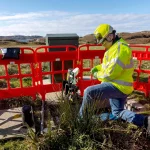EE UK Fills 12000km2 of UK Notspots for Mobile Network Coverage
Mobile operator EE has announced that they’ve “filled in” 12,000 square kilometres of mobile not-spots in the last 12 months, which forms part of their aim to extend geographic (landmass) 4G network coverage to 95% of the UK by the end of December 2020 (currently 90%).
In keeping with that EE says they’ve upgraded more than 4,000 existing sites to provide 4G and built 105 brand new sites (with a further 350 being built). The new sites, many of which are in areas that have previously had no coverage from any operator, are said to have already carried more than 200 emergency ‘999 calls‘ from people that may previously have been left without help.
For example, new 4G sites have been switched on in remote locations across Scotland, including Glencoe in the Scottish Highlands, CairnGorm Mountain, and the Isle of Skye, as well as West Dumfries and Galloway. This work has already seen geographic 4G coverage in Scotland pass the 75% mark at the end of 2017 (further than any other operator).
Advertisement
Marc Allera, CEO of EE, said:
“Our customers need a 4G connection wherever they go. We’ve added an enormous amount of coverage in the last year, upgrading existing sites and building completely new ones to keep our customers connected in more places than ever before. Mobile coverage is critical to consumers and businesses and can provide a lifeline for those in need of support from the emergency services – that’s why we keep focusing on filling in more mobile not-spots across Britain.”
We should point out that a lot of the new sites are being delivered as part of EE’s £1.2bn Emergency Services Network (ESN) contract with the government, which also means that rival operators will be able to place their own kit on some of the same infrastructure.
Meanwhile Ofcom recently adopted a much stricter way of measuring mobile network coverage, which will be applied when the regulator comes to auction off the 700MHz band and attach related coverage obligations (here). In other words, future bidders on that band will need to ensure that they’re able to deliver much stronger geographic coverage, particularly for 5G services.
Mark is a professional technology writer, IT consultant and computer engineer from Dorset (England), he also founded ISPreview in 1999 and enjoys analysing the latest telecoms and broadband developments. Find me on X (Twitter), Mastodon, Facebook, BlueSky, Threads.net and Linkedin.
« BT and Unions Agree to Tackle Multi-Billion Pensions Black Hole

















































Comments are closed